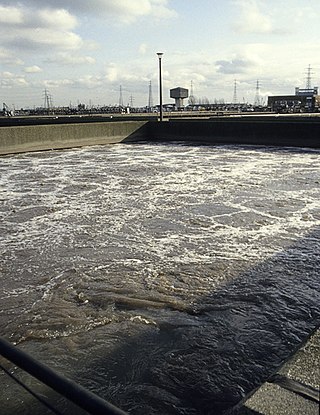
The San Francisco Public Utilities Commission (SFPUC) is a public agency of the City and County of San Francisco that provides water, wastewater, and electric power services to the city and an additional 1.9 million customers within three San Francisco Bay Area counties.

East Bay Municipal Utility District (EBMUD), colloquially referred to as "East Bay Mud", is a public utility district which provides water and sewage treatment services for an area of approximately 331 square miles (860 km2) in the eastern side of the San Francisco Bay. As of 2018, EBMUD provides drinking water for approximately 1.4 million people in portions of Alameda County and Contra Costa County in California, including the cities of Richmond, El Cerrito, Hercules, San Pablo, Pinole, Lafayette, Moraga, Orinda, Danville, Oakland, Piedmont, Emeryville, Berkeley, Albany, Alameda, San Leandro, neighboring unincorporated regions, and portions of cities such as Hayward and San Ramon. Sewage treatment services are provided for 685,000 people in an 88-square-mile area (as of 2018). EBMUD currently has an average annual growth rate of 0.8% and is projected to serve 1.6 million people by 2030. Headquartered in Oakland, EBMUD owns and maintains 2 water storage reservoirs on the Mokelumne River, 5 terminal reservoirs, 91 miles (146 km) of water transmission aqueducts, 4,100 miles (6,600 km) of water mains, 6 water treatment plants (WTPs), 29 miles (47 km) of wastewater interceptor sewer lines and a regional wastewater treatment facility (WWTF) rated at a maximum treatment capacity of 320 MGD.
The Central Contra Costa Sanitary District (CCCSD), also called Central San, provides sanitary sewage transport and treatment for the central portion of Contra Costa County, California. The main facility is a 54-million-US-gallon (200,000 m3) per day treatment plant in residential Martinez, California and it provides service to approx 462,000 residents. It operates and maintains 1,500 miles (2,400 km) of sewer lines out of its second location in Walnut Creek, California. It is a California Energy Commission Showcase Plant.
The Clark County Water Reclamation District (District) is a government wastewater treatment agency in Clark County, Nevada. As a member of the Southern Nevada Water Authority, its mission is to treat millions of gallons of wastewater that is produced every day. The District is the largest water treatment agency in Southern Nevada and is responsible for treating wastewater from unincorporated parts of Clark County within the Las Vegas Valley, including most of the Las Vegas Strip, and the communities of Blue Diamond, Moapa Valley, Indian Springs, Laughlin, and Searchlight.

The Hyperion Water Reclamation Plant is a sewage treatment plant in southwest Los Angeles, California, next to Dockweiler State Beach on Santa Monica Bay. The plant is the largest sewage treatment facility in the Los Angeles Metropolitan Area and one of the largest plants in the world. Hyperion is operated by the City of Los Angeles, Department of Public Works, and the Bureau of Sanitation. Hyperion is the largest sewage plant by volume west of the Mississippi River.

Riverbank State Park is a 28-acre (11 ha) state park built on top of a sewage treatment facility on the Hudson River, in the New York City borough of Manhattan. It was opened in 1993. On September 5, 2017, it was renamed Denny Farrell Riverbank State Park, after longtime New York State Assembly member Denny Farrell who represented the surrounding area.

The New River flows north from near Cerro Prieto, through the city of Mexicali, Baja California, Mexico, into the United States through the city of Calexico, California, towards the Salton Sea. The river channel has existed since pre-historic times. The river as known today formed from a levee failure and massive flooding that filled the Salton Sea.

Arcata Wastewater Treatment Plant and Wildlife Sanctuary is an innovative sewer management system employed by the city of Arcata, California.
Dallas Water Utilities (DWU) is the water and wastewater service operated by the City of Dallas, Texas, in the United States. DWU is a non-profit City of Dallas department that provides services to the city and 31 nearby communities, employs approximately 1450 people, and consists of 26 programs. DWU's budget is completely funded through the rates charged for water and wastewater services provided to customers. Rates are based on the cost of providing the services. The department does not receive any tax revenues. Primary authority and rules for the department are listed in Chapter 49Archived 2006-10-04 at the Wayback Machine of the Dallas City Code.
Water supply and sanitation in the United States involves a number of issues including water scarcity, pollution, a backlog of investment, concerns about the affordability of water for the poorest, and a rapidly retiring workforce. Increased variability and intensity of rainfall as a result of climate change is expected to produce both more severe droughts and flooding, with potentially serious consequences for water supply and for pollution from combined sewer overflows. Droughts are likely to particularly affect the 66 percent of Americans whose communities depend on surface water. As for drinking water quality, there are concerns about disinfection by-products, lead, perchlorates, PFAS and pharmaceutical substances, but generally drinking water quality in the U.S. is good.
Clean Water Services is the water resources management utility for more than 600,000 residents in urban Washington County, Oregon and small portions of Multnomah County, Oregon and Clackamas County, Oregon, in the United States. Clean Water Services operates four wastewater treatment facilities, constructs and maintains flood management and water quality projects, and manages flow into the Tualatin River to improve water quality and protect fish habitat. They are headquartered in Hillsboro.

The Presidential Memorial Commission of San Francisco was a voter group that sponsored a satirical but real 2008 ballot initiative to rename the Oceanside Water Pollution Control Plant, a wastewater treatment plant in San Francisco, California, after outgoing Republican U.S. President George W. Bush. The resulting proposed ordinance, Proposition R, would have taken effect immediately upon the inauguration of Bush's successor if passed. It was, however, voted down decisively in the November 2008 San Francisco general election, with "no" votes outnumbering "yes" votes by a margin of more than two-to-one.

The November 2008 San Francisco general elections were held on November 4, 2008 in San Francisco, California. The elections included seven seats to the San Francisco Board of Supervisors, one seat to the San Francisco County Superior Court, and twenty-two San Francisco ballot measures.

Beckton Sewage Treatment Works, formerly known as Barking Sewage Works, is a large sewage treatment plant in Beckton in the east London Borough of Newham, operated by Thames Water.

"Chicken" John Joseph James Rinaldi is a musician, showman, activist, and author living in San Francisco, California. He is involved with the San Francisco arts community as well as the Burning Man community. In what he referred to as "an experiment", he was a candidate in the 2007 San Francisco mayoral election, during which he wore fake mustaches, debated a puppet, and arranged costumed flash mobs to occur at campaign events, in an effort to be as flippant a candidate as possible.
Before 2008, San Diego County historically had been a Republican stronghold. The Republican presidential nominee carried the county in every presidential election from 1948 through 2004, except in 1992 when Bill Clinton won a plurality. In 2008, Barack Obama became the first Democratic presidential candidate to win a majority of votes in San Diego County since World War II; he won a majority of county votes again in 2012. In 2016, Hillary Clinton won the county by almost 20%, the largest margin for a Democratic presidential candidate since 1936. In 2020, Joseph R Biden, Jr. won by an even larger 22.7% margin.
The Southeast Water Pollution Control Plant, also called the Southeast Treatment Plant, is a wastewater treatment plant operated by the San Francisco Public Utilities Commission, in San Francisco, California, United States. It is located in the southeastern portion of the city in the Bayview-Hunters Point neighborhood.

The Everett Water Pollution Control Facility is a wastewater treatment plant in Everett, Washington, United States. It serves the city of Everett and discharges treated water into the Snohomish River. The facility is located at the south end of Smith Island, adjacent to Interstate 5 and Spencer Island Regional Park, a noted birdwatching spot.

The San José–Santa Clara Regional Wastewater Facility is a wastewater treatment plant located in the Alviso neighborhood of San Jose, California. The facility treats 110 million U.S. gallons of wastewater per day, with a capacity of up to 167 million U.S. gal/d (630 ML/d), making it the largest tertiary treatment plant in the western United States. It serves 1.5 million residents and over 17,000 business facilities in eight cities. The 2,600-acre (1,100 ha) site is operated by the San Jose Environmental Services Department and jointly owned by the cities of San Jose and Santa Clara. It began operations in 1956 to address severe water pollution issues and played a key role in San Jose's aggressive annexation program during the 1950s and 1960s.

The West Point Treatment Plant is a large wastewater treatment plant in Seattle. It is located in the Magnolia neighborhood, within Discovery Park. It is at the tip of West Point, near the West Point Lighthouse. The plant opened in 1966. It treats wastewater from the city of Seattle and other nearby communities. In 2017, the plant suffered a catastrophic flood that disabled it for months.













